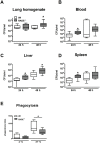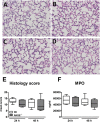Receptor for Advanced Glycation End Products (RAGE) Serves a Protective Role during Klebsiella pneumoniae - Induced Pneumonia
- PMID: 26824892
- PMCID: PMC4732606
- DOI: 10.1371/journal.pone.0141000
Receptor for Advanced Glycation End Products (RAGE) Serves a Protective Role during Klebsiella pneumoniae - Induced Pneumonia
Abstract
Klebsiella species is the second most commonly isolated gram-negative organism in sepsis and a frequent causative pathogen in pneumonia. The receptor for advanced glycation end products (RAGE) is expressed on different cell types and plays a key role in diverse inflammatory responses. We here aimed to investigate the role of RAGE in the host response to Klebsiella (K.) pneumoniae pneumonia and intransally inoculated rage gene deficient (RAGE-/-) and normal wild-type (Wt) mice with K. pneumoniae. Klebsiella pneumonia resulted in an increased pulmonary expression of RAGE. Furthermore, the high-affinity RAGE ligand high mobility group box-1 was upregulated during K. pneumoniae pneumonia. RAGE deficiency impaired host defense as reflected by a worsened survival, increased bacterial outgrowth and dissemination in RAGE-/- mice. RAGE-/- neutrophils showed a diminished phagocytosing capacity of live K. pneumoniae in vitro. Relative to Wt mice, RAGE-/- mice demonstrated similar lung inflammation, and slightly elevated-if any-cytokine and chemokine levels and unchanged hepatocellular injury. In addition, RAGE-/- mice displayed an unaltered response to intranasally instilled Klebsiella lipopolysaccharide (LPS) with respect to pulmonary cell recruitment and local release of cytokines and chemokines. These data suggest that (endogenous) RAGE protects against K. pneumoniae pneumonia. Also, they demonstrate that RAGE contributes to an effective antibacterial defense during K. pneumoniae pneumonia, at least partly via its participation in the phagocytic properties of professional granulocytes. Additionally, our results indicate that RAGE is not essential for the induction of a local and systemic inflammatory response to either intact Klebsiella or Klebsiella LPS.
Conflict of interest statement
Figures





Similar articles
-
The receptor for advanced glycation end products impairs host defense in pneumococcal pneumonia.J Immunol. 2009 Apr 1;182(7):4349-56. doi: 10.4049/jimmunol.0801199. J Immunol. 2009. PMID: 19299735
-
Interleukin-1 receptor-associated kinase M-deficient mice demonstrate an improved host defense during Gram-negative pneumonia.Mol Med. 2012 Sep 25;18(1):1067-75. doi: 10.2119/molmed.2011.00450. Mol Med. 2012. PMID: 22729155 Free PMC article.
-
Coagulation factor XI improves host defence during murine pneumonia-derived sepsis independent of factor XII activation.Thromb Haemost. 2017 Jul 26;117(8):1601-1614. doi: 10.1160/TH16-12-0920. Epub 2017 May 11. Thromb Haemost. 2017. PMID: 28492700
-
RAGE during infectious diseases.Front Biosci (Schol Ed). 2011 Jun 1;3(3):1119-32. doi: 10.2741/215. Front Biosci (Schol Ed). 2011. PMID: 21622260 Review.
-
Receptor for Advanced Glycation End Product (RAGE) Modulates Inflammation During Feeding of the Hard Tick, Haemaphysalis longicornis in Mice.Parasite Immunol. 2024 Jun;46(6):e13039. doi: 10.1111/pim.13039. Parasite Immunol. 2024. PMID: 38838041 Review.
Cited by
-
Coalescence of RAGE in Lipid Rafts in Response to Cytolethal Distending Toxin-Induced Inflammation.Front Immunol. 2019 Feb 26;10:109. doi: 10.3389/fimmu.2019.00109. eCollection 2019. Front Immunol. 2019. PMID: 30863392 Free PMC article.
-
Gut Microbiota in Patients with Type 1 Narcolepsy.Nat Sci Sleep. 2021 Nov 6;13:2007-2018. doi: 10.2147/NSS.S330022. eCollection 2021. Nat Sci Sleep. 2021. PMID: 34785965 Free PMC article.
-
Glycation & the RAGE axis: targeting signal transduction through DIAPH1.Expert Rev Proteomics. 2017 Feb;14(2):147-156. doi: 10.1080/14789450.2017.1271719. Epub 2016 Dec 22. Expert Rev Proteomics. 2017. PMID: 27967251 Free PMC article. Review.
-
DNA-Aptamer Raised against Receptor for Advanced Glycation End Products Improves Survival Rate in Septic Mice.Oxid Med Cell Longev. 2021 Aug 7;2021:9932311. doi: 10.1155/2021/9932311. eCollection 2021. Oxid Med Cell Longev. 2021. PMID: 34413930 Free PMC article.
-
RAGE-Mediated Suppression of Interleukin-10 Results in Enhanced Mortality in a Murine Model of Acinetobacter baumannii Sepsis.Infect Immun. 2017 Feb 23;85(3):e00954-16. doi: 10.1128/IAI.00954-16. Print 2017 Mar. Infect Immun. 2017. PMID: 28052995 Free PMC article.
References
-
- Kollef MH, Kollef KE (2005) Antibiotic utilization and outcomes for patients with clinically suspected ventilator-associated pneumonia and negative quantitative BAL culture results. Chest 128: 2706–2713. - PubMed
-
- Shorr AF, Tabak YP, Killian AD, Gupta V, Liu LZ, Kollef MH (2006) Healthcare-associated bloodstream infection: A distinct entity? Insights from a large U.S. database. Crit Care Med 34: 2588–2595. - PubMed
-
- Giamarellou H (2005) Multidrug resistance in Gram-negative bacteria that produce extended-spectrum beta-lactamases (ESBLs). Clin Microbiol Infect 11 Suppl 4: 1–16. - PubMed
Publication types
MeSH terms
Substances
LinkOut - more resources
Full Text Sources
Other Literature Sources
Molecular Biology Databases

